Water-Efficient Landscape Gardens in July
Home » Fair Oaks Horticulture Center » WEL Gardens » July in the WEL
The WEL gardens at the Fair Oaks Horticulture Center are open to the public seven days a week from sunrise to sunset for self-guided tours.
Wheelchair accessible, the gardens feature natives, commonly available perennials, trees, shrubs, and plants from other Mediterranean climates that do well with less water during our long, hot, dry summers and tolerate our chilly, damp Sacramento County winters. Most plants are labeled and many are UC Davis Arboretum All-Stars. The landscape demonstrates how home gardeners can be smart about using the water we have to create beautiful landscapes. Click here for resources about gardening with limited water.
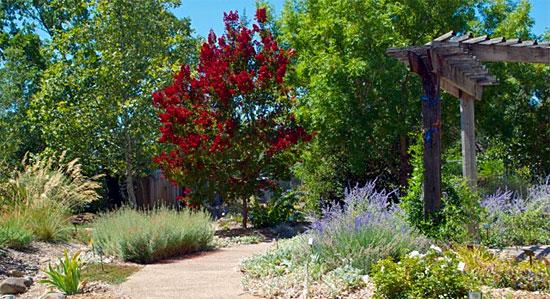
Harvest Day will be in person at the Fair Oaks Horticulture Center this year! You won't want to miss this! For details, please visit our Harvest Day page.
Summer peaks this month with long, dry, often very hot days and balmy nights. Golden, shimmering ornamental grass flower stalks act as backgrounds and focal points for heat loving buckwheats, lantanas, crape myrtles, sunflowers, black-eyed susans, goldenrod, gold flower, coral yucca, and more. Cooling gray, green and lavender colored Russian sages, Cape plumbago, ruellia, junipers and caryopteris provide alternative calming choices to the riot of bright blooms elsewhere in the garden. Our drought tolerant rose shrubs: ‘Mutabilis’ (or the butterfly rose), ‘Perle d’Or”, the China rose ‘White Pearl in Red Dragon’s Mouth’, and ‘Noaschnee’, a white ground-cover rose continue to rebloom regularly attracting bees and other beneficial insects. Bees, butterflies, birds and beneficial insects drift happily about the garden all day long.
Garden chores this month include weeding out newly germinating annual weeds such as bedstraw, spotted spurge, and oxalis before they set seed, controlling bindweed and pulling up oak and other tree sprouts while watching out for garden pests and diseases. (The Weed Identification Photo Gallery is a good guide to identifying and controlling weeds.)
We will also be deadheading salvias, penstemons, black-eyed susans and other continuously flowering perennials to promote longer bloom periods. (A good resource for flower problems is the UC Integrated Pest Management website). Additional mulching will be done to cover to a depth of 2 to 4 inches around plants to keep weeds down, conserve soil moisture and moderate soil temperatures. Irrigation lines and emitters will be checked for clogs, cuts and breaks regularly and schedules will be monitored. (See more irrigation tips.)
In addition to the plants, pathways, patios, raised planters, drip irrigation, a dry creek bed and permeable pavement demonstrate water wise, sustainable alternatives for gardeners who are considering replacing or reducing their lawns.
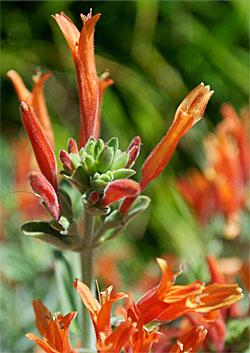
|
Dicliptera sericea (was D. suberecta) |
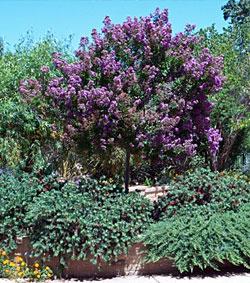
‘Catawba’
|
Lagerstroemia indica ‘Catawba’, 'Dynamite’ Hot summer bloom in full sun, striking bark, fall color, attractive to beneficial insects, hardy in winter, low to moderate water users, these small trees and shrubs are widely planted in Sacramento and for good reason. They do really well here. Recent hybrids introduced by the U.S. National Arboretum have been selected for hardiness and mildew resistance. Many of these have Native American names such as ‘Zuni’, ‘Arapaho’ and ‘Hopi’. Our 2 selections, ‘Catawba’ shown here and ‘Dynamite’ shown above were selected for their size (up to 20 feet), bright summer bloom and orange-red fall color. Blooming on new wood, they are often pruned back in winter or early spring to control growth and promote abundant flowering. A UC Davis Arboretum All-Star selection. |
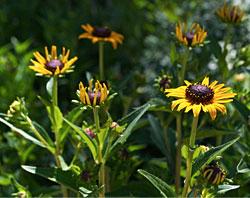
|
Rudbeckia fulgida ‘Goldsturm’ Brightly blooming along the entrance of our perennial pathway, these cheery, golden summer icons welcome our garden visitors all summer long. Originally from eastern North America, these members of the aster family were enthusiastically received by European horticulturalists as early as the 18th century where they were named by Linneaus in 1753 to honor his teacher, Swedish botanist Olaus Rudbeck. ‘Goldsturm’, our pathway stalwart was originally bred in Czechoslovakia and honored as the 1999 Perennial Plant of the Year. Requiring nothing more than average garden soil and moderate watering, these heat lovers attract bees and other beneficial insects. With deadheading they re-bloom into fall. They spread via rhizomatous roots that benefit from dividing every 3 to 4 years. While hardy, it does die back in winter making it an ideal succession companion for spring bulbs and other early flowering perennials. |
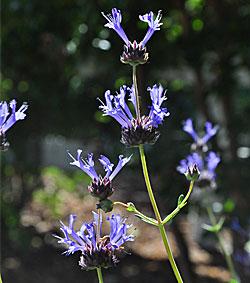
'Winnifred Gilman'
|
Salvia clevelandii ‘Whirly Blue’, Winnifred Gilman’ These California native, sun loving, small evergreen shrubs grow 3 to 5 feet tall and 5 to 8 feet wide. Brilliant blue-violet flower whirls on maroon colored stems appear from spring to early summer. Flowers invite hummingbirds, butterflies and beneficial insects to visit, and make attractive dried flowers. A member of the sage family, it has an easily recognized aromatic fragrance when the leaves are bushed lightly. Heat and drought tolerant once established. ‘Winnifred Gilman’ is a UC Davis Arboretum All-Star. |
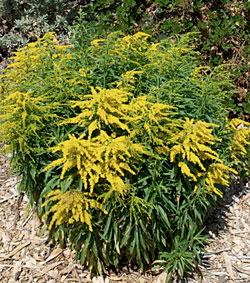
‘Golden Baby’
|
Solidago velutina ssp. californica ‘Cascade Creek’ Solidago californica ‘Cascade Creek’, makes a cheery addition to the summer perennial pathway. Growing to 2 feet tall, 18 inches wide, it starts blooming in June and continues throughout our long hot summer continuously into fall attracting bird and butterflies. A tough plant that thrives in any soil type, it can take part shade and moderate to occasional water. Cut to the ground after bloom has ended in the fall. We don’t recommend planting the parent native goldenrod, Solidago californica, because it grows taller and can be invasive. Solidago californica ‘Cascade Creek’ is a UC Davis Arboretum All-Star. |



